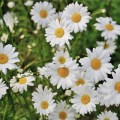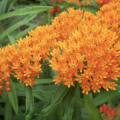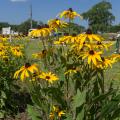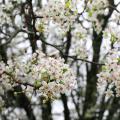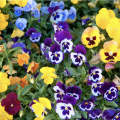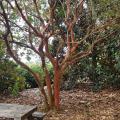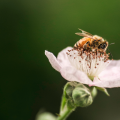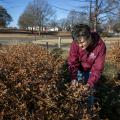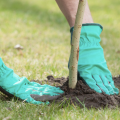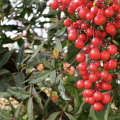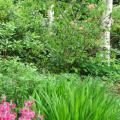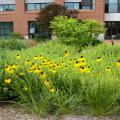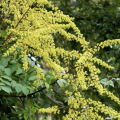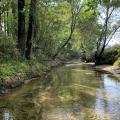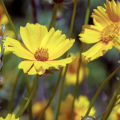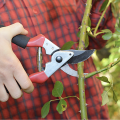News Filed Under Landscape Architecture
After an unseasonal cold snap in March, spring has officially started and the warmer weather is here to stay– at least for a little while. Hopefully, the cold didn’t damage your plants! Working on your yard is a great excuse to spend time outside now that the weather is nice. Here are a few things you can work on in your landscape for the month of April:
I woke up to a dusting of yellow pollen on my car this week, the true sign that spring is on its way! Several flowers are blooming, making the world a little more vibrant after a cold, gray winter.
Native plants have garnered a lot of attention, especially because of their relationship to pollinators, but these plants are valuable for many other reasons. In addition to pollen, they provide food and shelter for birds and other wildlife, as well as creating biodiversity in the ecosystem.
If you have Bradford pear trees on your property, you are quite familiar with the odor they release. How could such a beautiful tree smell like rotting fish? The odor isn’t the only thing that makes this tree undesirable.
The weather has been brutal lately. Cold and dreary one day, warm the next. Nevertheless, signs of spring are starting to pop up. Yellow daffodils have already started to bloom, providing everyone with a reminder that the cold weather will soon be moving out of the area.
Crape myrtles are popular for their low-maintenance beauty, but they can benefit from some light pruning this time of year.
Pssst…You know you don’t have to be a beekeeper to help support honey bees, right?
STARKVILLE, Miss. -- A water sampling program conducted by the Mississippi State University Extension Service has encouraging initial data about lead levels in drinking water collected at child care centers around the state.
Preliminary data gathered as part of the SipSafe program paint a reassuring picture for most of the faucets sampled.
Plants across the state that suffered from the unusually cold weather just days before Christmas will need some help recovering from damage they suffered in the deep freeze. Mike Brown, state climatologist and Mississippi State University meteorologist, said Mississippi’s average late December temperature is 44 degrees on the coast, 38 degrees in central Mississippi and 34 degrees in north Mississippi.
Curb appeal is what everyone aims for, but how do you get that great looking yard? We all want a landscape that looks like it’s straight out of a magazine, and 2023 is the year to make it happen! Each month, we’ll put out a quick checklist of tasks to stay on top of yard maintenance. Here’s January’s list:
Heavenly bamboo, commonly referred to as nandina, is a popular, evergreen landscape plant that produces vibrant red berries and resembles hollies.
If you have an area in your yard where you want to create a border between property lines, reduce noise from busy streets, or soften a fence line, we have a solution
Mississippi gardeners who work to nurture nature in their landscape can learn from some of the top leaders in this field in an Oct. 19 event at Mississippi State University. The 67th Edward C. Martin Landscape Symposium will be hosted by the MSU Extension Service on campus at the Bost Center Auditorium. Registration for the half-day event is $25 in advance or $30 at the door.
COMO, Miss. -- The Mississippi State University Extension Service will cohost a collaborative field day in Panola County Sept. 29 to share information about cover crops and reduced-till farming, soil and water health, and pasture soil and water management.
The Mississippi Land Stewardship field day runs from 9 a.m. to 1 p.m. and begins at Buckeye Farms at 3251 Tom Floyd Road in Como. Attendees will then travel to two different fields, one row crop and one pasture. The field day will conclude at Home Place Pastures. A complimentary lunch is included for participants.
Pruning is one of the least understood gardening tasks and for good reason – it’s confusing. When, how, and if you should prune depends on the type of plant or tree you have and your goal for the plant. Check out these pruning tasks for the last one-third of the year.
STARKVILLE, Miss. -- The presence of a water source on private land can make a property much more desirable for several reasons. Whether it’s a lake, pond, stream or river, a water source provides opportunities for recreation, development, agricultural production, and wildlife and fisheries habitat.
A key aspect of maintaining the value of the water resource is ensuring that it is protected and used wisely.
SHAW, Miss. -- Mississippi State University scientists will cohost a collaborative field day in the Mississippi Delta on July 13 to share information about cover crops, soil and water health, and irrigation automation and efficiency.
The Soil and Water Stewardship in Row-Crop Systems field day runs from 9 a.m. to 1 p.m. and begins at Mosco Farm at the southwest of 813 US-61 in Shaw. Attendees will travel to Clements Farm and finish the event at the West F.A.R.M. Pavilion. A complimentary catfish lunch is included for registered participants.
Native plants are great to have in the landscape because they often do not require watering, fertilization, or maintenance. They grow naturally in the region and are adapted to the overall climate and soil conditions. Native plants also provide food and shelter for wildlife and pollinators!
Pruning is one of the least understood gardening tasks and for good reason – it’s confusing. When, how, and if you should prune depends on the type of plant or tree you have and your goal for the plant.
There’s no plant more iconic in the springtime than azaleas. Their bright, colorful blooms are exactly what we need to welcome the warm weather after a dreary winter.

